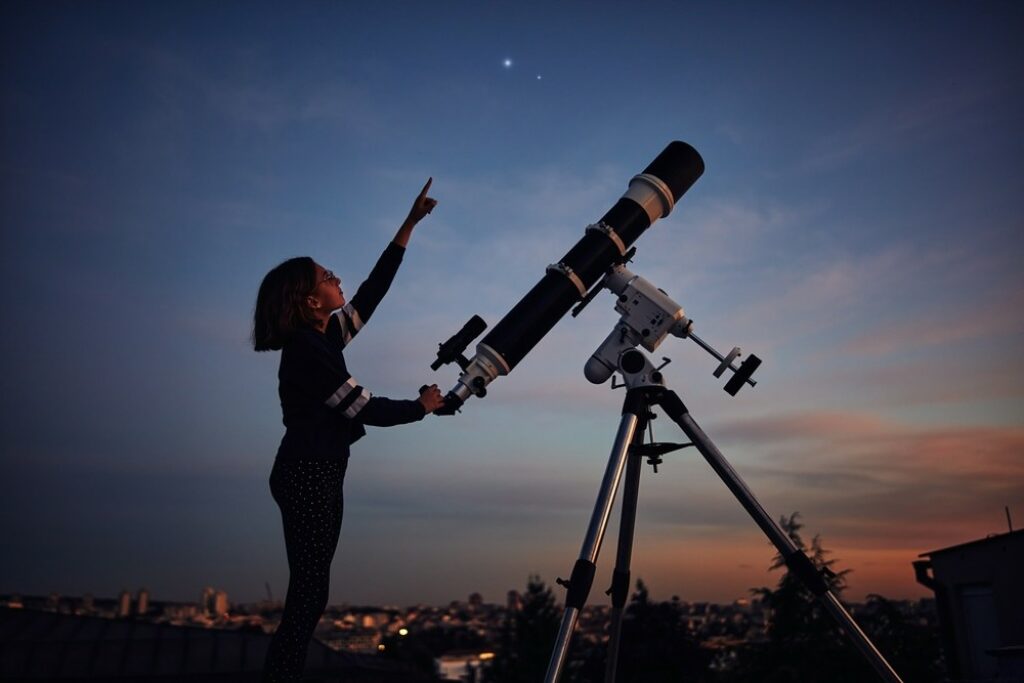
Best Telescopes
Whether you’re new star gazer or an experienced sky watcher, having the right telescope can enhance your stargazing experience. The market is filled with a vast array of telescopes and accessories, making it hard for an uninformed consumer to make the right decision on what type of telescope to buy.
Related Topics (Sponsored Ads):
When it comes to choosing the best telescope for amateur use, there are several factors to consider such as ease of use, portability, and the ability to view celestial objects with clarity. This article will explore five of the best telescopes for amateur astronomers, providing detailed information on each telescope’s features, advantages, disadvantages, and suitability for beginners. Additionally, itwill include tips on how to choose a telescope to help readers make informed decisions.

Celestron NexStar 4SE
Features:
4-inch (102mm) aperture
Focal length of 1325mm
Fully computerized mount with SkyAlign technology
Comes with a 25mm Plossl eyepiece
Suitable for viewing planets and bright sky objects
Advantages:
Easy to use and set up, making it perfect for beginner astronomers
SkyAlign technology allows for auto-finding various targets within the night sky
Sturdy design with a solid mount and tripod
Suitable for backyard stargazing
Disadvantages:
Not the most portable due to its weight and tripod design
Power-hungry, requiring external power source for prolonged use
Fairly narrow field of view, limiting its capability to fit bigger deep sky objects into the view
Suitability:
The Celestron NexStar 4SE is an ideal choice for beginners who want a telescope that is easy to set up and use. It is also suitable for backyard stargazing enthusiasts who primarily want to view planets and bright sky objects.
Celestron Advanced VX 8 EdgeHD
Features:
EdgeHD technology for improved astrophotography
Optically excellent telescope suitable for visual astronomy
Can handle a weight of up to 30 lbs (13.6kg)
Includes NexStar+ hand controller, a 40mm eyepiece, and access to Celestron’s SkyPortal app and Starry Night Special Edition software
Advantages:
EdgeHD technology provides a perfectly flat field for sharp and detailed astrophotography
Crisp and clear views with no optical distortion or false color
Stable and secure support for the tube and accessories
Suitable for serious amateurs and long-term astronomy enthusiasts
Disadvantages:
Mount may be unsteady for serious astrophotography, requiring a different mount
Restrictive portability and narrow field of view
Requires a significant investment for advanced features
Suitability:
The Celestron Advanced VX 8 EdgeHD is best suited for serious amateurs and enthusiasts who are interested in high-quality visual astronomy and astrophotography.
Celestron NexStar 5SE
Features:
Primary 5-inch mirror
Fully computerized system with electronic GPS database preloaded with celestial objects
Handheld controller for easy alignment and focusing
Weighs 15 pounds, making it portable and easy to set up on location
Advantages:
Light-gathering capacity for crisp images of solar system objects
Sufficient power to explore deep-sky objects
Fully computerized system for easy alignment and tracking
Portable and suitable for on-location stargazing
Disadvantages:
Relatively smaller aperture compared to other models
Limited light-gathering ability compared to larger telescopes
May not be suitable for advanced astrophotography
Suitability:
The Celestron NexStar 5SE is ideal for curious amateurs interested in exploring both solar system and deep-sky objects. Its portable design makes it suitable for on-the-go stargazing experiences.
Astronomers Without Borders OneSky Reflector Telescope
Features:
Collapsible design for portability and easy storage
130mm aperture and 650mm focal length
Comes with two eyepieces for versatile viewing options
Simple and user-friendly setup
Advantages:
Portable and easy to transport for on-the-go stargazing
Suitable for beginners and casual sky watchers
Provides good value for its price point
Versatile viewing options with included eyepieces
Disadvantages:
Limited light-gathering ability compared to larger telescopes
Basic features may not satisfy advanced users
Collapsible design may compromise stability
Suitability:
The Astronomers Without Borders OneSky Reflector Telescope is an excellent choice for beginners and casual stargazers who prioritize portability and user-friendly setup.
Sky-Watcher Classic Dobsonian Telescope (8-inch)
Features:
8-inch aperture and 1200mm focal length
Sturdy and stable Dobsonian mount
Simple and intuitive design for easy manual tracking and adjustments
Suitable for deep-sky observations and wide-field views
Advantages:
Large aperture for impressive light-gathering and detailed views
Stable and sturdy Dobsonian mount for easy manual tracking
Suitable for deep-sky observations and wide-field views
Provides excellent value for its performance and price
Disadvantages:
Bulky and less portable compared to other designs
Manual tracking and adjustments may require more effort compared to computerized systems
Limited advanced features for astrophotography
Suitability:
The Sky-Watcher Classic Dobsonian Telescope (8-inch) is best suited for amateur astronomers interested in deep-sky observations and wide-field views. Its stable and intuitive design makes it ideal for observers who prefer manual tracking and adjustments.
Tips for Choosing a Telescope
Consider your observing needs and interests, whether it’s planetary viewing, deep-sky observations, or astrophotography.
Evaluate the portability and storage requirements based on your living space and stargazing preferences.
Research different mount types and consider the ease of tracking and alignment options.
Determine your budget and balance it with the desired features and performance.
Seek advice from local astronomy clubs and experienced observers for firsthand experiences and recommendations.
Conclusion
The best telescope for amateur use depends on individual preferences, observing goals, and budget. Whether you’re a beginner, casual stargazer, or aspiring astrophotographer, there are telescopes available to suit your needs. By considering the features, advantages, and disadvantages of each model, along with the tips for choosing a telescope, you can make an informed decision to enhance your stargazing experience.




